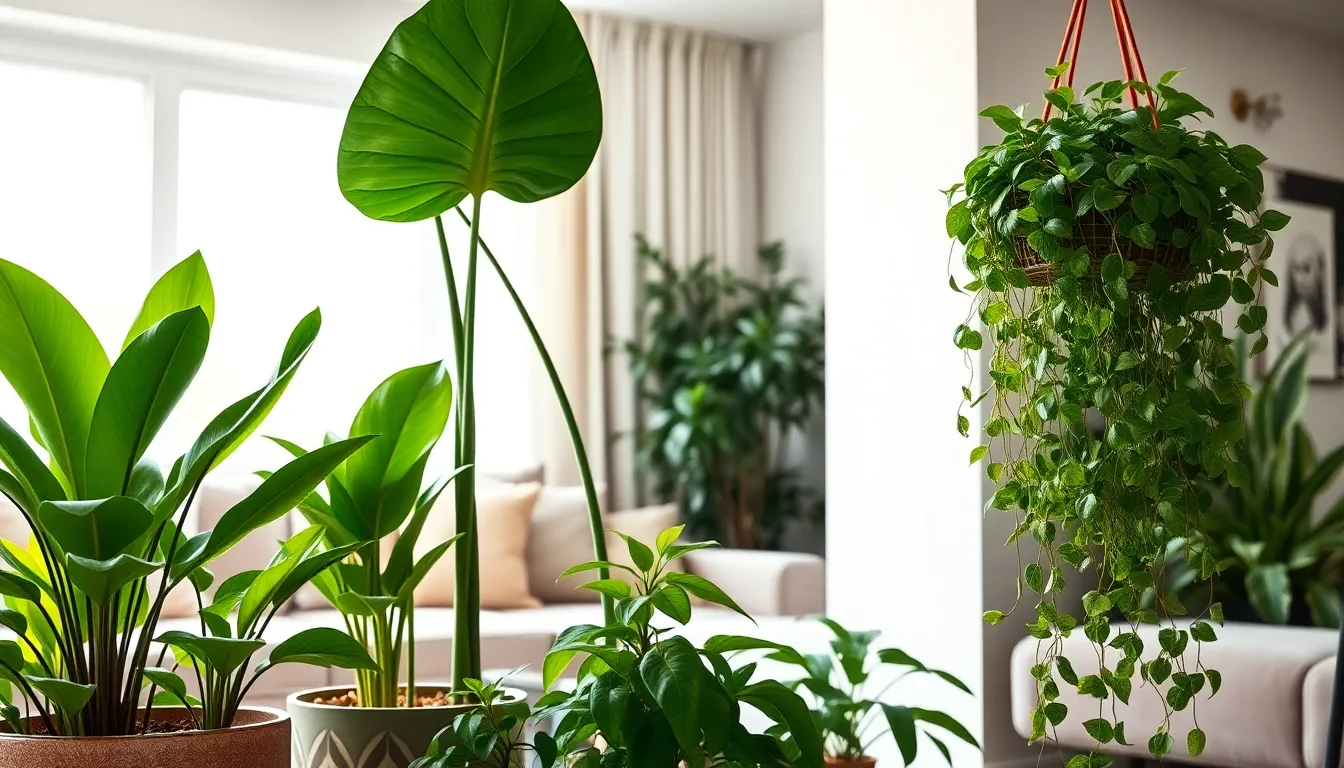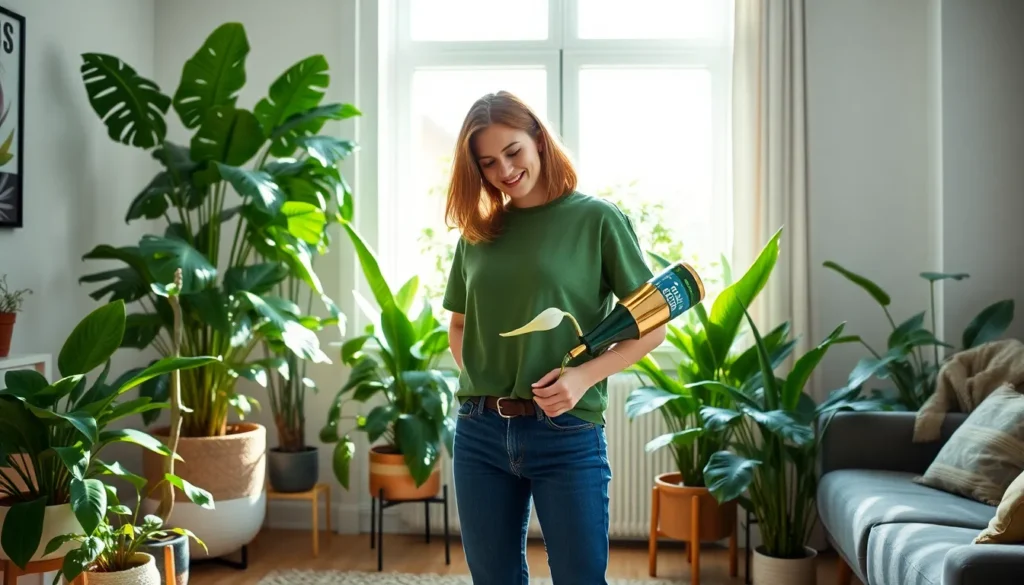Table of Contents
ToggleImagine stepping into a room that feels alive, where the air is fresher and the vibe is just a bit more zen. That’s the magic of interior plants. They’re not just decorations; they’re the secret sauce to transforming any space into a sanctuary. Whether it’s a tiny succulent on your desk or a towering fiddle leaf fig in the corner, these green companions can uplift your mood and even boost productivity.
But let’s face it—keeping plants alive can feel like a game of survival. Fear not! With the right tips and tricks, anyone can become a plant parent without turning their home into a jungle. Dive into the world of interior plants and discover how they can elevate your living space while adding a splash of personality. Who knew that bringing the outdoors in could be so rewarding—and so much fun?
Benefits Of Interior Plants
Interior plants offer numerous advantages that enhance living spaces and overall well-being. Many enjoy the visual appeal and fresh air that plants provide, making them valuable components of home decor.
Improved Air Quality
Indoor plants purify the air by absorbing pollutants. Studies demonstrate that plants like snake plants and peace lilies effectively filter common toxins including formaldehyde and benzene. Increased oxygen levels result from the photosynthetic process of these plants, promoting a healthier breathing environment. Regular exposure to plants reduces indoor humidity and can help alleviate respiratory issues, benefiting both individuals and those with allergies.
Enhanced Aesthetics
Aesthetic appeal enhances living environments significantly through interior plants. Various species, such as fiddle leaf figs or pothos, add color and texture to any room. Personalizing spaces becomes effortless with different pots and arrangements. Complementing existing decor not only elevates style but also creates a sense of natural harmony. Unique plant varieties can also serve as conversation starters, enriching social interactions in the home.
Psychological Benefits
Plants contribute to improved mental health and well-being. Engaging with greenery fosters a calming atmosphere that reduces stress and anxiety. Research indicates that people report higher happiness levels when surrounded by plants. Increased productivity often accompanies the presence of plants, as they promote concentration and creativity. Incorporating greenery into daily life supports emotional resilience, making interior spaces more uplifting and inviting.
Best Types Of Interior Plants

Interior plants come in various forms, each suited to specific needs and preferences. Exploring different categories reveals options for every space and lifestyle.
Low-Maintenance Options
Snake plants thrive on neglect, requiring minimal watering and light. ZZ plants adapt to low light and irregular watering, making them ideal for busy individuals. Pothos plants offer resilience with trailing vines that look appealing in containers or hanging baskets. These options work well for beginner gardeners or those with limited time.
Air-Purifying Plants
Spider plants effectively filter indoor air, removing toxins and promoting a healthier environment. Peace lilies not only enhance aesthetics but also clear harmful chemicals like formaldehyde. Rubber plants contribute significantly to air purification while adding lush greenery to any decor. Each of these plants plays a crucial role in creating a fresher living space.
Trendy Houseplants
Monstera deliciosa captivates hearts with its distinctive split leaves, becoming a centerpiece in modern interiors. Fiddle leaf figs stand tall, commanding attention with their large, glossy leaves. Calatheas offer a stunning array of patterns and colors, bringing life to any room. Choosing trendy houseplants infuses style along with their numerous benefits.
Caring For Interior Plants
Caring for interior plants requires attention to detail and an understanding of their specific needs. Each plant species has unique requirements that contribute to their health and vitality.
Watering Tips
Watering needs vary greatly among plants. Snake plants prefer dry conditions, while peace lilies thrive in moist soil. It’s vital to check soil moisture before watering. Overwatering can lead to root rot, so always use well-draining pots. A general rule is to water when the top inch of soil feels dry. Providing room temperature water promotes plant health and encourages consistent growth.
Light Requirements
Light requirements also differ across plant types. Low-light plants like ZZ plants flourish in darker corners, while Monstera deliciosa requires bright, indirect light for optimal growth. Observing sun patterns in a room helps identify the best spot for placing plants. Rotate plants regularly to ensure even light exposure. Indoor plants often benefit from supplemental grow lights during winter months, especially if natural light is limited.
Common Pests
Common pests like spider mites, aphids, and mealybugs can threaten indoor plants. Regularly inspecting foliage helps catch infestations early. Using insecticidal soap effectively reduces pest populations. Neem oil offers a natural approach, providing both treatment and prevention. Keeping plants clean by wiping down leaves with a damp cloth prevents dust buildup and discourages pests. Monitoring your plants and acting quickly ensures they remain healthy and vibrant.
Decorating With Interior Plants
Interior plants add character and warmth to any living space. They provide not only aesthetic benefits but also contribute to overall well-being.
Creative Arrangements
Arranging plants creatively enhances the visual appeal of a room. Grouping plants of varying heights creates dynamic layers. Hanging planters can bring green life to vertical spaces, while shelf arrangements showcase smaller plants like succulents. Using decorative pots complements a room’s decor and highlights the plants’ features. Consider placing larger plants in corners to create focal points.
Using Plants In Different Rooms
Different rooms benefit from specific plant selections. Bright, sunny spaces like living rooms thrive with sun-loving plants such as fiddle leaf figs and rubber plants. Kitchen environments suit herbs like basil and mint, which can double as decor and culinary ingredients. Bedrooms often benefit from peace lilies and snake plants, known for their air-purifying properties. Bathrooms provide a humid environment perfect for ferns and pothos, which flourish in low-light conditions.
Seasonal Decor Ideas
Seasonal decorations can integrate plants in festive ways. In spring, vibrant flower pots bring freshness to living areas. During summer, tropical plants like monstera provide a lively atmosphere. Fall arrangements work well with colorful foliage plants, adding rich autumn tones. Winter months can feature poinsettias or small evergreen trees for a festive touch. These seasonal transitions keep interiors engaging throughout the year.
Bringing interior plants into a home can truly elevate both the atmosphere and the well-being of its inhabitants. These green companions not only enhance aesthetics but also contribute to a healthier living environment. With the right approach to care and placement, anyone can enjoy the myriad benefits that plants offer.
Whether it’s the calming presence of a peace lily or the striking look of a fiddle leaf fig, each plant can add a unique touch to a space. Embracing the world of indoor gardening opens up a realm of possibilities for creativity and personalization. By integrating greenery into daily life, individuals can foster a refreshing and vibrant atmosphere that nurtures both body and mind.




